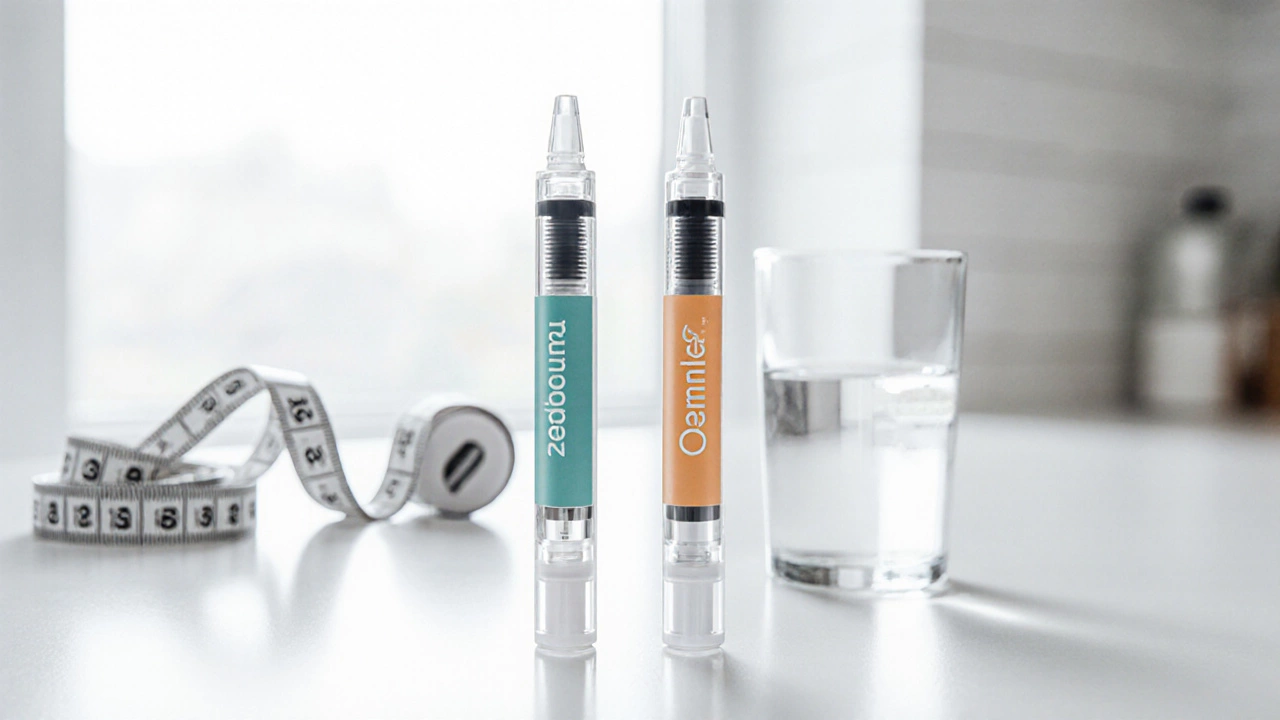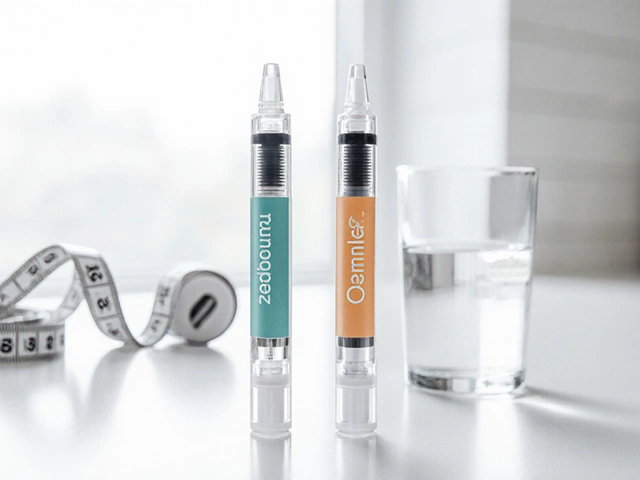- Home
- ::
- Zepbound vs Ozempic: Which Weight‑Loss Drug Wins?

Zepbound vs Ozempic: Which Weight‑Loss Drug Wins?
Weight Loss Calculator: Zepbound vs Ozempic
How much weight could you lose?
Enter your current weight to see estimated weight loss with Zepbound and Ozempic based on clinical trial data.
Quick takeaways
- Zepbound (tirzepatide) typically delivers 15‑20% average body‑weight loss, a notch higher than Ozempic’s 10‑15%.
- Both drugs are FDA‑approved GLP‑1‑based injectables, but Zepbound also activates the GIP pathway, giving it a metabolic edge.
- Side‑effect profiles overlap (nausea, vomiting, constipation), yet Zepbound may cause slightly more GI upset at the start.
- Cost per month is comparable in the U.S., but insurance coverage varies; online pharmacies can shave 10‑30% off retail price.
- Choosing the right drug hinges on your health goals, tolerance for side effects, and how easily you can access the medication online.
When the buzz about Zepbound (tirzepatide) hit the headlines, people immediately asked the same question they ask about every new weight‑loss injectable: "Is it better than the tried‑and‑true Ozempic?" This article cuts through the hype, compares the two drugs head‑to‑head, and shows you how to get them safely through an online pharmacy.
What are Zepbound and Ozempic?
Zepbound is a once‑weekly injectable that contains tirzepatide, a synthetic peptide that mimics both glucose‑dependent insulinotropic polypeptide (GIP) and glucagon‑like peptide‑1 (GLP‑1). It received FDA approval in 2023 for type‑2 diabetes and in 2024 for chronic weight management.
Ozempic contains semaglutide, a GLP‑1 receptor agonist approved by the FDA in 2017 for diabetes and in 2021 for obesity under the brand name Wegovy (same molecule, higher dose). Both sit in the GLP‑1 drug family but differ in how they hit the body’s appetite and glucose controls.
How do they work?
Ozempic’s semaglutide binds exclusively to the GLP‑1 receptor. This triggers three main effects: slower gastric emptying, increased insulin secretion when glucose is high, and reduced appetite via brain pathways. Think of it as turning down the hunger switch while keeping blood sugar in check.
Zepbound’s tirzepatide is a dual‑agonist: it activates the GLP‑1 receptor *and* the GIP receptor. GIP was once ignored, but recent research shows it can boost insulin response and, when combined with GLP‑1, amplify weight‑loss signals. The result is a stronger metabolic push that often translates into greater pounds shed over the same time frame.
Weight‑loss efficacy
Clinical trials give us hard numbers. In the SURMOUNT‑2 study, participants on Zepbound lost an average of 15‑20% of their baseline weight after 72 weeks, depending on dose. Ozempic’s STEP‑1 trial showed about 10‑15% loss over a similar period. The difference may look modest, but for someone trying to drop 30kg, that extra 5‑10% can mean the difference between hitting a goal or falling short.
Both drugs maintain the loss if you stay on therapy, but stopping leads to gradual regain. The key is pairing the medication with a realistic diet and activity plan-no pill works miracles on its own.

Safety and side‑effects
The most common complaints for both are gastrointestinal: nausea, vomiting, diarrhea, or constipation. Because tirzepatide hits two receptors, the initial weeks can feel a bit harsher; many doctors start patients at the lowest dose (2.5mg weekly) and titrate up.
Serious concerns are rare but shared-pancreatitis, gallbladder disease, and possible thyroid C‑cell tumors (based on animal data). The FDA requires a black‑box warning for both, so you’ll need a prescription and regular monitoring.
Overall, the safety profile is comparable, with Zepbound edging slightly higher on the nausea‑scale during dose escalation.
Dosing, administration, and convenience
Both are once‑weekly subcutaneous injections, usually delivered with a pre‑filled pen. Ozempic starts at 0.25mg for four weeks, then moves to 0.5mg, with the obesity dose (Wegovy) at 2.4mg. Zepbound begins at 2.5mg weekly, then steps up in 2.5mg increments to a max of 15mg.
From a user standpoint, the pens are similar-simple click‑and‑inject devices. The main difference is the titration schedule: Zepbound requires more frequent dose changes, which may be a nuisance for some users.
Cost, insurance, and buying online
In the United States, a month’s supply of Ozempic runs about $900, while Zepbound is roughly $1,000 at the highest dose. Prices vary by pharmacy, insurance copay, and whether you qualify for manufacturer coupons.
Online pharmacies can shave 10‑30% off retail prices if they offer legitimate discounts and verify prescriptions. Look for pharmacies that are licensed in your state, display a pharmacist’s contact info, and use secure HTTPS connections. Avoid “miracle” sites that promise no‑prescription sales-those are illegal and dangerous.
For UK readers, both drugs are available through the NHS for diabetes, but weight‑loss indications generally require private purchase. Online UK pharmacies that are MHRA‑registered can supply the medication after a tele‑consultation with a qualified prescriber.

Choosing the right drug for you
If you need the biggest possible weight loss and can tolerate a slightly tougher start, Zepbound usually wins. If you prefer a simpler titration schedule, have a lower dose budget, or already use semaglutide for diabetes, Ozempic may be the better fit.
Talk to your endocrinologist or primary‑care doctor about your medical history, insurance coverage, and lifestyle. A short trial of each (under medical supervision) can help you feel the difference before committing long‑term.
Bottom line
Both Zepbound and Ozempic are powerful tools in the fight against obesity, but Zepbound’s dual‑agonist action gives it a modest edge in weight‑loss numbers. Safety, cost, and convenience are similar, so the final decision boils down to personal tolerance and how easily you can get the drug-especially through a reputable online pharmacy.
| Attribute | Zepbound (tirzepatide) | Ozempic (semaglutide) |
|---|---|---|
| Active ingredient | tirzepatide | semaglutide |
| FDA approval year | 2023 (diabetes), 2024 (weight loss) | 2017 (diabetes), 2021 (weight loss) |
| Primary indication | Type‑2 diabetes, chronic weight management | Type‑2 diabetes, obesity (Wegovy dose) |
| Weekly dose range | 2.5mg - 15mg | 0.25mg - 2.4mg |
| Average weight loss % (36weeks) | 15‑20% | 10‑15% |
| Common side effects | Nausea, vomiting, diarrhea, constipation | Nausea, vomiting, diarrhea, constipation |
| Cost per month (US$) | ≈$950‑$1,050 | ≈$850‑$950 |
| Online pharmacy availability | Yes, via licensed U.S./UK pharmacies | Yes, via licensed U.S./UK pharmacies |
Frequently Asked Questions
Can I switch from Ozempic to Zepbound?
Yes, most clinicians will taper Ozempic off while starting Zepbound at the lowest dose. A short overlap period can help avoid a sudden loss of glycemic control. Always do this under medical supervision.
Do I need a prescription to buy these drugs online?
Both Zepbound and Ozempic are prescription‑only. Reputable online pharmacies require a valid prescription and a tele‑consult with a licensed prescriber before shipping.
Which drug works faster for weight loss?
Both start showing measurable weight loss after about 8‑12 weeks. Zepbound’s higher efficacy may become evident a few months later, but the early timeline is similar.
Are there any long‑term risks?
Long‑term data are still emerging, especially for Zepbound. The main concerns are pancreatitis, gallbladder disease, and potential thyroid tumor risk (observed in animal studies). Regular follow‑ups are essential.
Can I get these medications through the NHS?
Ozempic is available on the NHS for type‑2 diabetes, but not for obesity. Zepbound is not yet listed for weight loss in the UK, so a private prescription and purchase through a licensed online pharmacy are required.

 Health and Wellness
Health and Wellness





Write a comment